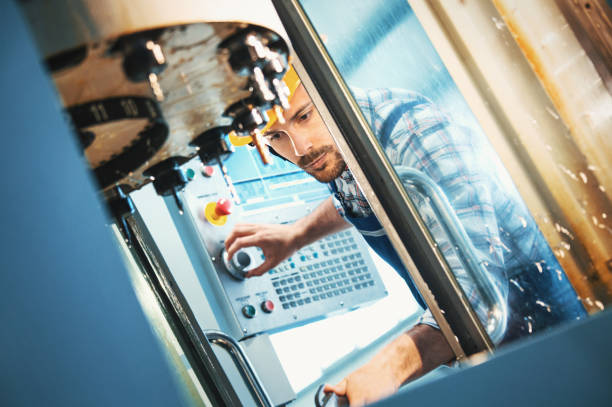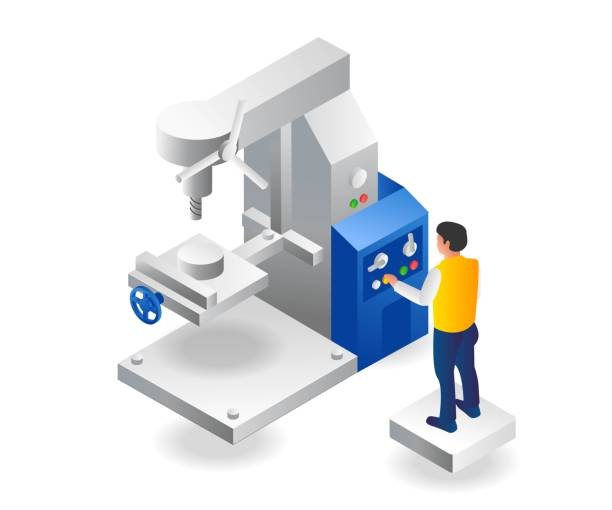Numerical control (NC) is the automated computer-controlled operation of machining tools like drills, boring tools, lathes, and 3D printers. A CNC machine uses coded, computer-generated instructions to process a piece of material to fulfill requirements without the help of a manual operator.
- CNC is a subtractive process that removes material from a solid block or a pre-formed object using a range of cutting tools.
- A CAD model is often provided by the customer and defines the geometry of the final product.
- The machinist creates the cutting paths and tool selections necessary to produce the item using CAM software.
- The pathways are then sent out as Gcode, which contains the exact CNC guidelines, including the positioning and orientation of the machine head, the position of the part, and the speed of any movement.
- The machine is prepared, and the blank has been jigged into place.
- The machine typically operates with little supervision while it runs the Gcode to take out the material and create the part.
PROS AND CONS OF CNC MACHINING
PROS
CNC is completely automated, making it cost-effective for high-quality production. Almost any material can be used with CNC.
- Some are really accurate.
- Compared to other methods, parts of CNC machines are less susceptible to internal strain and have good physical qualities.
- Setup costs are relatively cheap, allowing jobs to be swiftly performed again later.
- Changes can be introduced quickly and simply for development or within the course of production.
CONS
CNC is not the most cost-effective method, particularly for extremely large quantities, where injection molding can be more cost-effective.
- The setup cost is higher than that of rapid prototyping.
- CNC typically produces only one item at a given time, and cycle times for complex parts can be longer when compared to injection molding.
- Since subtractive processes produce waste, this waste may or may not be recyclable.
- Part geometry is limited because of tool access and work holding.
- The price of complex geometry is high.
There are many different kinds of CNC machines, some of which use lasers, electrochemical processes, water, water jets, and electron beams.
PROCESS SELECTION
| PROCESS | RELATIVE COST | PRO | CON |
| CNC Lathe | 85% | lowest part cost compared to other CNC machining processes. | can only create parts with simple geometry and rotational symmetry. |
| Very high production capabilities. | |||
| CNC Mill | 100% | Can produce most parts with simple geometries. | Manual repositioning of work-piece lowers achievable accuracy. |
| High accuracy & tight tolerances. | Tool access & work-holding design restrictions apply. | ||
| Mill Turning CNC Center | 125% | Lowest cost relative to 5-axis CNC machining systems. | Tool access restrictions still apply. |
| High production capabilities & design freedom. | Most suitable for parts with a cylindrical outline. | ||
| Indexed 5 Axis | 160% | Eliminates the need for manual repositioning. | Higher cost than 3-axis CNC machining. |
| greater accuracy is used to produce parts with features that are not aligned to one of the primary axes. | Tool access design restrictions apply. | ||
| Continuous 5 Axis | 200% | produces intricate parts with a level of precision and detail that is impossible with any other process. | Highest cost per part of all CNC machining. |
| Produces very smooth ‘organic’ surfaces with minimal machining marks. | Tool access restrictions still apply. |
CNC Machining Design Guidelines: Cost Reduction Tips
Following specific CNC guidelines can help to decrease the costs of CNC machining while retaining high quality and precision. In this section, we’ll look at different CNC design best practices that you may use to cut the cost of CNC machining.
The following are important CNC guides to help you get the most out of your CNC design:
Always Choose Softer Material

Using a softer material is an important strategy in CNC machine design to lower CNC machining costs. Since softer materials are often simpler to manufacture, cutting speeds can be increased and tool wear can be decreased. Shorter machining periods and reduced costs are possible as a result of this.
Softer materials are also less likely to break or distort during machining, improving product quality and speeding up post-machining processing. Softer materials might not be appropriate for high-pressure or high-wear applications, so it’s important to think about the intended usage and final application of your product.
Reduce Work Holding Setups and Tool Changes
One of the most important recommendations in CNC machining design is that it may significantly cut down the overall price and duration of your machining processes. A machining cycle gets longer and more costly as additional tool changes and setups are needed. Consider the following design principles to reduce tool changes and setups:
- Design your parts of CNC machine such that they can be produced with a single tool and have similar features and geometry.
- Utilize multi-functional tools that allow you to complete several tasks with just one change of tools.
- Use modular fixtures that can hold many parts to reduce setup times by designing for CNC machining with uniform orientations.
Avoid Draft Angles and Non-Planar Surfaces.
It can be difficult and complex to process non-planar and draft angle surfaces, which can lead to slower cutting rates, longer machining times, and more tool wear. Additionally, these surfaces may make it more difficult to attain tight tolerances and consistent item quality. To keep your CNC machine design free of non-planar and draft angle surfaces:
- When using geometry, aim to keep it flat and basic.
- Use radii and fillets to minimize complex surfaces and soften sharp corners.
- Include draught angles in your design to make it simple to remove material and lessen tool wear when cutting.
Increase the Internal Fillets’ Size
Your machining operations can be made much more effective and high-quality by using this simple CNC machine design technique. Internal fillets have rounded edges or transitions that help strengthen a part by reducing stress concentrations. You can enhance the machining procedure by raising the size of these fillets by doing the following:
- Reducing machining’s cutting forces and tool wear.
- Improving the material flow and chip removal when cutting.
- Reducing the possibility of tool failure and early tool wear.
- Improving part quality and surface finish.
Add Undercuts to Sharp Corners
Corner undercuts, which are notches or recesses in a part, help with material removal and tool access during machining. They’re used to
- Minimize tool wear and cutting forces.
- Enhance material flow and chip removal during cutting.
- Lessen the possibility of tool failure and early tool wear.
- Enhance the part quality and surface finish.
However, they might be tricky to reach with common cutting tools, and making undercuts can be a difficult and demanding process. Additionally, to machine undercuts, specialized equipment or multi-axis machining may be needed. Getting better results can be improved by reducing the quantity and complexity of undercuts. When creating undercuts, the following factors need to be taken into account.
| Recommended | |
| Undercut dimension | 3 mm to 40 mm |
| Undercut clearance | 4x depth |
Standard Tolerances
Standard tolerances help CNC machining make sure the produced product satisfies the necessary specifications and operational requirements. Tight tolerances that aren’t required can make machining more expensive and time-consuming. Manufacturers can decrease the requirement for secondary processes and increase overall machining efficiency by defining standard CNC machining service tolerances.
| Recommended | Feasible | |
| Tolerances | ±0.1 mm | ±0.02 mm |
Other Articles You Might Enjoy
- Precision CNC Machining of Steel: High-Volume Production
Precision CNC Machining and High-Volume Production As an integral part of modern manufacturing processes, Precision Computer Numerical Control (CNC) machining brings about unmatched accuracy and consistency in the production of…
- Material Versatility in CNC Machining: From Titanium to Thermoplastics
Introduction to CNC Machining CNC machining stands as a cornerstone in the manufacturing sector, enabling the precise creation of parts and components. This process utilizes computer numerical control (CNC) to…
- Precision CNC Machining for High-Performance Industrial Machinery
Precision CNC Machining for High-Performance Industrial Machinery The process of Precision CNC (Computer Numerical Control) machining is at the core of manufacturing high-performance industrial machinery. This technique leverages a computer's…









